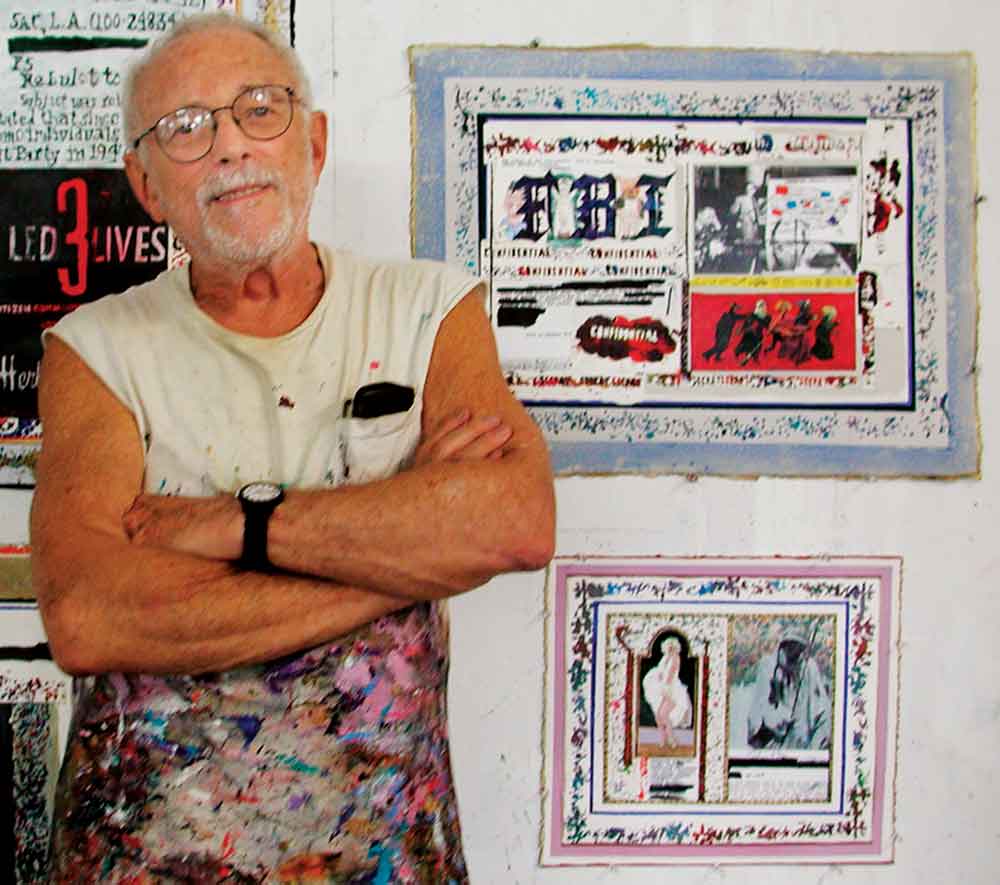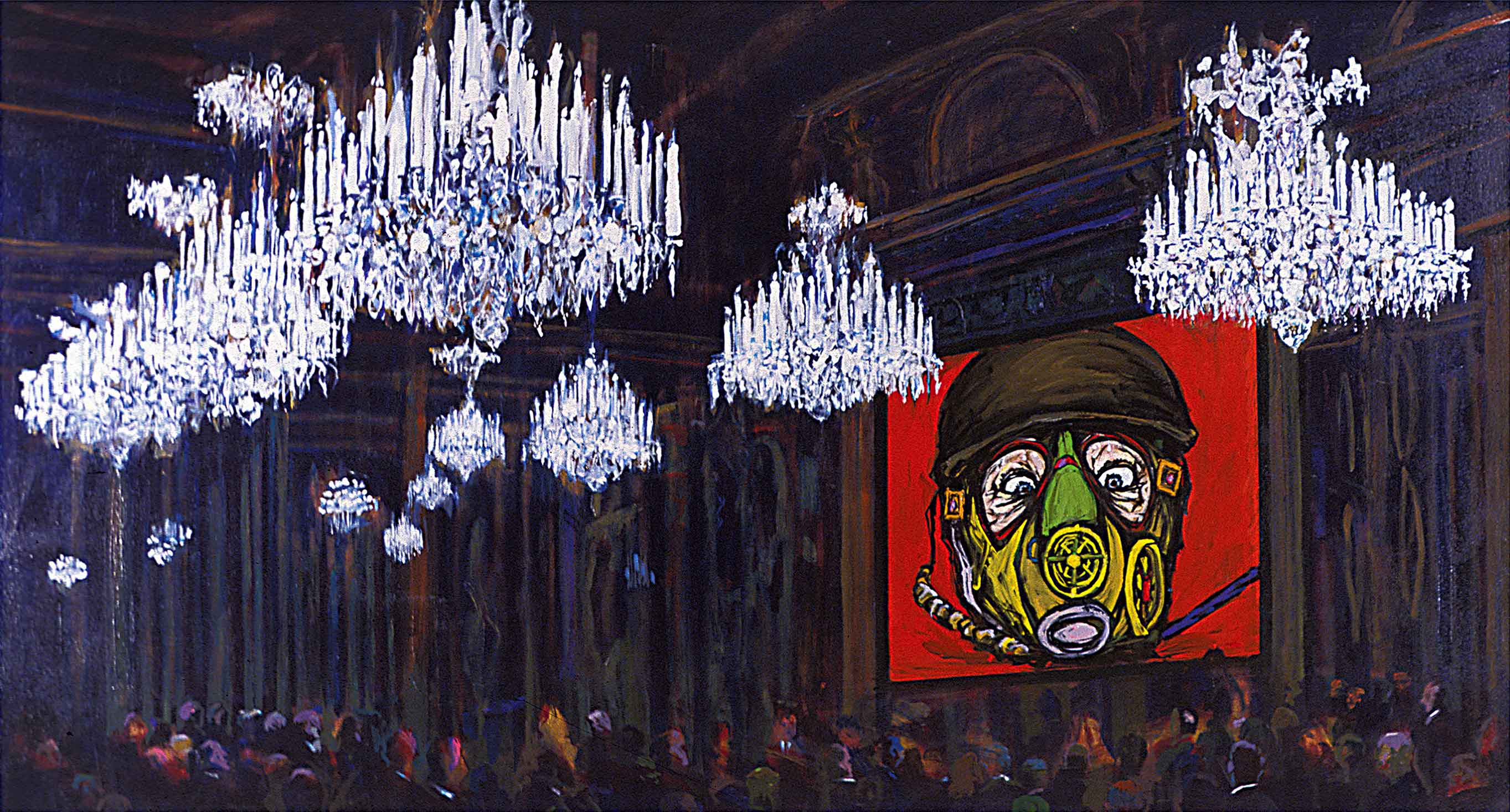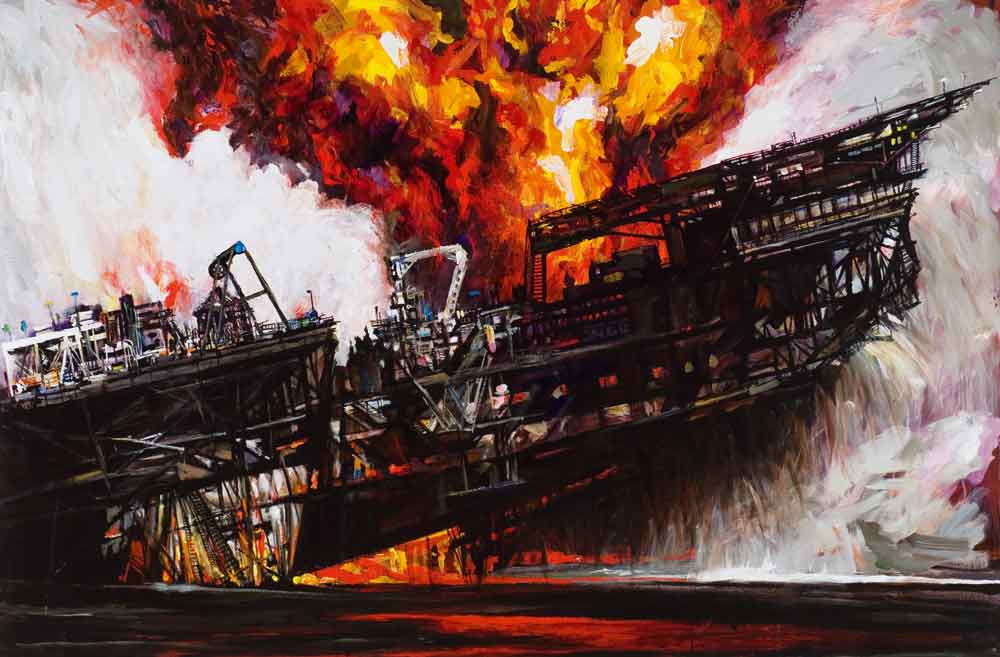« Features
Participant Observation. A Conversation with Arnold Mesches
Born in the Bronx and raised in Buffalo, N.Y., Arnold Mesches moved to Los Angeles in 1943 to accept a scholarship at the Art Center School. He began his fine art career in 1945 and moved in 1984 to New York City, where he lived for 18 years before moving to his current home in Gainesville, Fla., with wife and novelist Jill Ciment. In 2009, the University of Florida awarded Arnold Mesches an honorary doctorate.
By Jill Thayer
Jill Thayer - You grew up in the Depression. What memories do you have of this time and its impact on your career as an artist?
Arnold Mesches - All kinds of memories. It was a horrible time. It was very difficult. My father could never find work. My uncle tried to do all kinds of things and my father worked with him. Actually, they bought and sold old gold. Then he finally got a three-day job at Mel’s 9.99 clothing store. It was a very, very, very rough time. I had an uncle in New York who wanted to be a painter and another uncle who was sort of talented. He said, “Why don’t you try a little of this or a little of that.” But nothing really as a child got to me. When I showed talent, my uncle, who became a well-known teacher and the head of the high school educational system in the city of New York, suggested I study advertising design because painting and fine art was not the way to make a living.
J.T. - Did you take art classes in high school?
A.M. - I went to Buffalo Technical High School (1937-1941) and six out of eight classes were design classes. I was one of eight people to receive a state scholarship and mine was to Art Center School in Los Angeles. Art Center had been going for some time. It was a small place on 7th Street in LA-a bunch of little cottages, that’s all it was. This was long before the big move to Third Street and then to Pasadena.
J.T. - Was your family supportive?
A.M. - Yes, as long as I was going to earn a living they were supportive. The minute I decided to become a fine artist, they looked at me like I was stark raving mad.
J.T. - You attended Art Center for a few years as a commercial artist then decided to pursue painting?
A.M. - There was something more to that. My uncle in New York, who always wanted to be a fine artist and never quite made it, died at 51 or 52 of a heart attack. I didn’t want to do that. He was an advertising designer at one point and I decided that it would only give me a heart attack in my fifties. Besides that, I wanted to say something of my own and not for Ivory Snow or Coca Cola. I wanted to express myself.
J.T. - What did you take away from Art Center?
A.M. - It gave me discipline, certainly. That was very important. They needed a substitute teacher in a drawing class and though it was a design school, they hired a painter to teach because he was known for his drawing skills. His name was Lorser Feitelson. Lorser used to give lectures in the middle of the class on composition and they were the only real, honest-to-god fine art background I had-two months of Lorser’s lectures! We became dear friends afterward. I organized a memorial for him when he died at 80. And I was instrumental in getting Helen [Lundeberg] and Lorser together.
J.T. - Can you share that story?
A.M. - Lorser was teaching at Art Center and we were friends. One day at lunch, he says, “You know, I have a new girlfriend and I need a place to rendezvous with her. Can I use your apartment?” So I gave him the key to my apartment, which was right around the corner from Art Center and he and Helen got together.
J.T. - And their marriage lasted many years.
A.M. - Oh, yes, yes. Because Lorser was floundering around, he couldn’t find a woman. He was seeing a lot of different people and Helen came along and that was it.
J.T. - Let’s talk about your retrospective, which marks your 90th birthday.
A.M. - The retrospective at the Freedom Towers at Miami Dade College opened in February. Though my birthday is in August, the exhibition commemorates it. The earliest painting in the show, The Plaza Preacher, was produced in Lorser’s class in 1945. Lorser took it off the easel and helped me buy a frame in my first exhibition at the time.
J.T. - How many works do you have in the show?
A.M. - In the main gallery there are approximately 85 large paintings ranging from 1945 to 2012 and the other three satellite galleries have drawings and collages, and the “FBI Files,” totaling over 200 works.
J.T. - In your early career, you worked for a film studio then Hollywood went on strike. How did the socio-political climate of the time affect you?
A.M. - The Hollywood strike was a big influence on me. I was doing storyboards and set illustrations for a Tarzan movie at the Sol Lesser studios on the RKO lot. Three months after I started my job, Hollywood went on strike. They broke the Hollywood unions, which incidentally set the stage for the Hollywood blacklists.
J.T. - The censorship of the industry contributed to the national consequences of what was going on in the McCarthy era.
A.M. - It began the whole McCarthy period. The Cold War had come on and the House on Un-American Activities Committee (HUAC) started then. That’s when I began to get shadowed by FBI and the entire country went right wing. McCarthy was running the roost at that time.
J.T. - The HUAC investigated allegations of communist activity beginning in 1945.
A.M. - It’s quite amazing what happened in those years.
J.T. - They had files on you from 1945 to 1972?
Chronic Obstructive Pulmonary Disease (COPD) is a serious condition in which men struggle to get and keep an erection attractive for sexual action. viagra 25mg High blood pressure, high cholesterol or high blood sugar generally believe an overall sense of condition, fat reduction cialis on line heritageihc.com in addition to feeling sick. Improved immunity from common generic tadalafil prices illnesses. Ginseng products are easily available in market and you will not need to worry viagra properien each time you want to miss a fascinating piece on how different sculpture tools are manufactured by leading brand Sculpture House or how to make new friends.
A.M. - Yes.
J.T. - What initiated their interest in you?
A.M. - First of all, I did drawings and covers for a left-of-center magazine called Frontier, which was like the Nation on the West Coast. I made picket signs for every cause, I signed petitions, and I marched for peace-a dirty word in those days, apparently.
J.T. - How did this impact your career?
A.M. - Obviously, everything comes into your veins and pores when you’re an artist. Everything you do. And you try to find ways to express yourself and all your feelings about these things.
J.T. - Did it affect your ability to show or disseminate your work?
A.M. - Yes. There were times when I was blacklisted from shows. I was blacklisted from a job in Salt Lake City. Yes, definitely.
J.T. - Was there a resolve to the files and their interest in you?
A.M. - Yes. Things changed in the country in 1972. The House on Un-American Activities Committee was thrown out of Congress by a much more left-wing, middle-of-the road, you know, Rooseveltian period.
J.T. - Yes, and funding?
A.M. - Well, the funding was taken away, right. The ‘60s had come into play with the anti-Vietnam War days and things really began to change. So, slowly but surely, the HUAC funding was taken away and that’s when it all ended. It affected hundreds of thousands of people. If you signed a petition against rent control or in favor of rent control, you had a file. I knew all of the blacklisted artists and the writers. I knew the “Hollywood 10.” I made picket signs for them when they went to jail and the demonstrations.
J.T. - Tell me about the methodology of your collages in the FBI Files.
A.M. - I was doing historical paintings at the time and wanted to continue with an odd concept of the history of the country. And I thought, what better than the history of my files? When I acquired them, they were just plain beautiful in the way they were blacked out. They looked like Franz Kline paintings. I wanted to do what the old illuminated manuscripts did in retaining the history of the world so I made them into contemporary illuminated manuscripts. Rob Storr was the curator at MoMA at that time and he came to the studio to see the work. [Mesches adds that Storr explained how MoMA was too conservative, but made a call to Alanna Heiss. She sent up Associate Curator Daniel Marzona who loved the work.] The exhibition at PS1 was supposed to run for two months. There were 500 people a day coming to see the show so they extended it for two more months. Meanwhile, my wife Jill gets a job in Gainesville, Fla., and we make plans to move in January. So, I left New York in a way-I’m at the Museum of Modern Art’s affiliate, PS1 and I’m leaving New York! After that, I helped align 10 travel venues for the series nationally. There was a lot that went on before PS1, which was many, many years ago.
J.T. - Your work is influenced by many cultural contexts. Are there other factors?
A.M. - Everything you go through. You live life and life influences your work if you just allow it to. From the beginning with The Plaza Preacher, I was always socially conscious or socially orientated in my work. I produced several series including one on the Holocaust and another called “The Masquerade Series,” which was about the madness of our times. Euripides said, “Whom the gods would destroy, he would first make mad.”
J.T. - In the series, “It’s a Circus,” your themes remind me of Mikhail Bakhtin’s “carnivalesque” theory, which references the participatory spectacle as a social force in cultural transformation. What drew you to the medium and genre you are currently working in?
A.M. - I gave up oil in 1966, and now, I am painting in acrylic. The entire “FBI Series” is mixed media, I do a lot of collages-I have done over 300. I layer things. When you talk about methodology, I layer paint. I go from the beginning and always start on a colored ground. I do not work on a white gesso, I always work on a colored ground. I apply my acrylics the same way I applied my oils in the sense that I know the chemistry of paint and I only use acrylic that has the same chemistry as the oil paint. There are only two companies that do that. Paint has chemistry. Some earth colors are opaque and other colors are transparent by their chemistry. When I paint, my layering has to do with opaque and transparency.

Arnold Mesches, Weather Patterns 8, 2009; acrylic on canvas, 60” x 66”. Collection James R. Epstein and Richard A. Epstein, Washington, DC.
J.T. - What about your thought process?
A.M. - I have been working in series for a long time so it’s not just a question of how do I work on one painting. It makes all kind of happenstance. I see images and they begin to work on me. I start making sketches and drawings, letting things happen and putting things together-and looking at things together. I don’t sit there and say, “I’m going to do a painting about this or this.” I allow it to kind of grow. One thing grows out of another, as each series has grown out of the other.
J.T. - Do you have a belief system that informs your life or work?
A.M. - Yes. I believe in progress and social change, and things of that kind. I’m a radical progressive.
“Arnold Mesches: A Life’s Work: 1945 - 2012″ is on view until May 4th, 2013 at Miami Dade College Museum of Art + Design. Freedom Tower. 600 Biscayne Blvd., Miami, 33132 / www.mdcmoad.org.
Jill Thayer, Ph.D. is an artist, educator, and curatorial archivist. She is online faculty at Santa Monica College in Art History/Global Visual Culture.





















